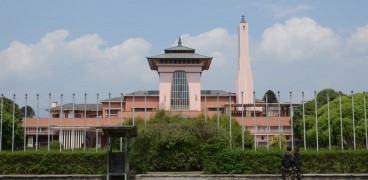Equipment List For Low and Moderate Altitude Trekking
1. Equipment And Clothing
These trekking equipment checklists are recommended and vital for both camping and tea house trekking in the Himalayas. Use them properly as a guide; some of the equipment can be rented in Kathmandu too. Also, remember trekking gear can be purchased in different adventure shops inside Kathmandu, most of the gear is nearby industrial. Simultaneously, it has become more common for equipment to be introduced from China and so of high-quality.
2. Luggage
- 1 Large Duffel Bag:
This carries all your personal equipment on the journey. It must be strong and robust. The suitable size is likely to be about 30" x 14", with a complete length zipper and handles.
- 1. Small Padlock:
Your duffel bag must be locked properly so that others cannot use your equipment without permission.
- 1 Rucksack Or Day Pack:
This should lodge a sweater, rain equipment, water bottle, camera and fittings and any assorted substances you like to have throughout the day. We suggest a pack with a minimum of 1450cu. In volume or smaller if you do not carry a huge sum of camera gear.
- 1 Small Duffel Bag/Suitcase:
Stuffs not required on the journey can be left at the hotel in Kathmandu. This bag must also have a lock. Make sure to consent for acquisitions, or purchase one in Kathmandu they have numerous high-quality ones accessible.
3. Head and Face Equipment
- Cap or Hat
- A Scarf
- Shades
- Warm hat
- Sunblock with a very high SPF factor
- Lip balm with a high SPF factor
4. Hands
- Lightweight handbags
- Durable gloves or mittens with a water-resistant shell surface
5. Outer Clothing
- Down Jacket
- Hustle Jacket (or a windproof jacket)
- Water-resistant jacket with a covering (or a poncho)
- Water-resistant jeans or denim
- Baggy pants
- A couple of gloves/mittens (1 thin and 1 thick)
- 1 pullover to be worn underneath the hustle jacket
6. Footwear
- Light-weight walking boots- (leather is suggested)
- Spare laces
- A couple of thick woollen socks.
- A couple of thin socks to be worn beneath the woollen socks.
- One pair of sandals or easy shoes for a campsite
7. Drinking Gear
- 1 Thermos
Water inclines to freeze in ‘normal’ water bottles at high elevation temperatures.
- 2 1-litre water bottles
- Sanitization Gear
Boiled drinking water will be offered, but more sanitization with iodine or sanitization drugs are very suggested.
8. Sleeping and Carrying Gear
- 30-40-litre backpack
- Backpack
Deprived of aluminium provision
- Water-Resistant Bag
A water-resistant bag to include the backpack
- Sleeping Bag
Carry a sleeping bag that can go along temperatures as low as -15 degrees Celsius.
9. Personal Medical Kit:
- Bandage for injures
- Bandages/Band-aids
- Iodine or water strainer
- Moleskin/Second skin - for wounds
- Sterile balm for cuts
- Anti-bacterial throat tablets (with antibacterial)
- Aspirin/paracetamol - general anaesthetic
- Oral rehydration salts
- Broad-spectrum antibiotic
- Anti-diarrhoea medicine (antibiotic)
10. Extras/Luxuries
- Reading book/ Novels
- Trail Map/Guide book
- Notebook & Pen
- personal stereo
- Travel game such as chess, backgammon, scrabble
11. Toiletries Equipment
- 1 medium-sized instant drying towels
- Toothbrush and paste (if possible bring recyclable)
- Versatile soap and detergent (if possible bring recyclable)
- Roll-on or body spray
- Nail cutters
- Face and body cream
- Female sanitation items
- Small Pocket mirror
Frequently termed as Acute Mountain Sickness (AMS) is mainly a significant medical deliberation during Nepal's treks. Height sickness indicates the consequence of elevation on those who climb too quickly to raise more than 2500 m.
The Early Symptoms of AMS Are Listed Below:
- Sickness, vomiting
- Loss of appetite
- Sleeplessness / Insomnia
- Determined pain
- Faintness, nausea, misunderstanding,
- Confusion, drunken manner.
- Faintness, weakness, tiredness, heavy legs.
- Slight inflammation of hands and face
- Breathing difficulty and breathing misdeed
- Condensed urine output.
Treatment for Acute Mountain Sickness (AMS)
- Provide enough time for adaptation (After about 2500 meters)
- Make sure you do not take speedy Climb.
- Do not take Alcohol, Sleeping pills and Smoke
- Drink additional liquid 3-4 Liters per day, clean water-boiled or treated /tea/coffee/soup/juice and much more.
- Ascent high and sleepless
- Do not hike/travel alone, take leader/porter
- Go after the instruction from your leader, hotel, local, guide book
- Descent if minor symptoms quickly getting worse.
- Never consent or descent sick person sideways.
The Final Touch,
These are some equipment list information for Nepal Travelers. If you are looking for a reliable travel agency in Nepal, feel free to connect with Hop Nepal.
















